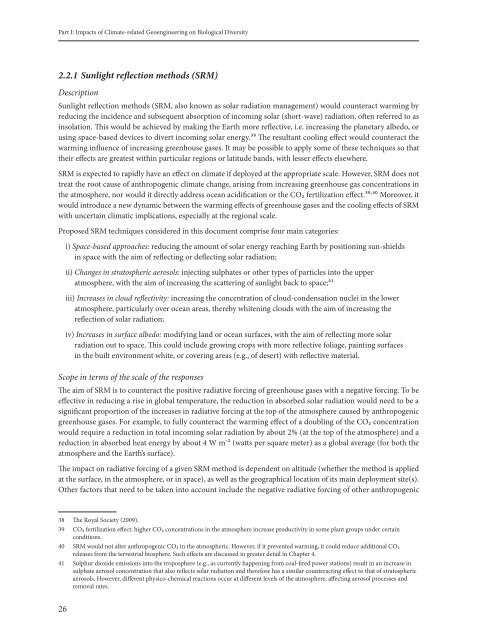cbd-ts-66-en
cbd-ts-66-en
cbd-ts-66-en
Create successful ePaper yourself
Turn your PDF publications into a flip-book with our unique Google optimized e-Paper software.
Part I: Impac<strong>ts</strong> of Climate-related Geo<strong>en</strong>gineering on Biological Diversity<br />
2.2.1 Sunlight reflection methods (SRM)<br />
Description<br />
Sunlight reflection methods (SRM, also known as solar radiation managem<strong>en</strong>t) would counteract warming by<br />
reducing the incid<strong>en</strong>ce and subsequ<strong>en</strong>t absorption of incoming solar (short-wave) radiation, oft<strong>en</strong> referred to as<br />
insolation. This would be achieved by making the Earth more reflective, i.e. increasing the planetary albedo, or<br />
using space-based devices to divert incoming solar <strong>en</strong>ergy.38 The resultant cooling effect would counteract the<br />
warming influ<strong>en</strong>ce of increasing gre<strong>en</strong>house gases. It may be possible to apply some of these techniques so that<br />
their effec<strong>ts</strong> are greatest within particular regions or latitude bands, with lesser effec<strong>ts</strong> elsewhere.<br />
SRM is expected to rapidly have an effect on climate if deployed at the appropriate scale. However, SRM does not<br />
treat the root cause of anthropog<strong>en</strong>ic climate change, arising from increasing gre<strong>en</strong>house gas conc<strong>en</strong>trations in<br />
the atmosphere, nor would it directly address ocean acidification or the CO2 fertilization effect.39, 40 Moreover, it<br />
would introduce a new dynamic betwe<strong>en</strong> the warming effec<strong>ts</strong> of gre<strong>en</strong>house gases and the cooling effec<strong>ts</strong> of SRM<br />
with uncertain climatic implications, especially at the regional scale.<br />
Proposed SRM techniques considered in this docum<strong>en</strong>t comprise four main categories:<br />
26<br />
i) Space-based approaches: reducing the amount of solar <strong>en</strong>ergy reaching Earth by positioning sun-shields<br />
in space with the aim of reflecting or deflecting solar radiation;<br />
ii) Changes in stratospheric aerosols: injecting sulphates or other types of particles into the upper<br />
atmosphere, with the aim of increasing the scattering of sunlight back to space;41<br />
iii) Increases in cloud reflectivity: increasing the conc<strong>en</strong>tration of cloud-cond<strong>en</strong>sation nuclei in the lower<br />
atmosphere, particularly over ocean areas, thereby whit<strong>en</strong>ing clouds with the aim of increasing the<br />
reflection of solar radiation;<br />
iv) Increases in surface albedo: modifying land or ocean surfaces, with the aim of reflecting more solar<br />
radiation out to space. This could include growing crops with more reflective foliage, painting surfaces<br />
in the built <strong>en</strong>vironm<strong>en</strong>t white, or covering areas (e.g., of desert) with reflective material.<br />
Scope in terms of the scale of the responses<br />
The aim of SRM is to counteract the positive radiative forcing of gre<strong>en</strong>house gases with a negative forcing. To be<br />
effective in reducing a rise in global temperature, the reduction in absorbed solar radiation would need to be a<br />
significant proportion of the increases in radiative forcing at the top of the atmosphere caused by anthropog<strong>en</strong>ic<br />
gre<strong>en</strong>house gases. For example, to fully counteract the warming effect of a doubling of the CO2 conc<strong>en</strong>tration<br />
would require a reduction in total incoming solar radiation by about 2% (at the top of the atmosphere) and a<br />
reduction in absorbed heat <strong>en</strong>ergy by about 4 W m-2 (wat<strong>ts</strong> per square meter) as a global average (for both the<br />
atmosphere and the Earth’s surface).<br />
The impact on radiative forcing of a giv<strong>en</strong> SRM method is dep<strong>en</strong>d<strong>en</strong>t on altitude (whether the method is applied<br />
at the surface, in the atmosphere, or in space), as well as the geographical location of i<strong>ts</strong> main deploym<strong>en</strong>t site(s).<br />
Other factors that need to be tak<strong>en</strong> into account include the negative radiative forcing of other anthropog<strong>en</strong>ic<br />
38 The Royal Society (2009).<br />
39 CO2 fertilization effect: higher CO2 conc<strong>en</strong>trations in the atmosphere increase productivity in some plant groups under certain<br />
conditions.<br />
40 SRM would not alter anthropog<strong>en</strong>ic CO2 in the atmospheric. However, if it prev<strong>en</strong>ted warming, it could reduce additional CO2<br />
releases from the terrestrial biosphere. Such effec<strong>ts</strong> are discussed in greater detail in Chapter 4.<br />
41 Sulphur dioxide emissions into the troposphere (e.g., as curr<strong>en</strong>tly happ<strong>en</strong>ing from coal-fired power stations) result in an increase in<br />
sulphate aerosol conc<strong>en</strong>tration that also reflec<strong>ts</strong> solar radiation and therefore has a similar counteracting effect to that of stratospheric<br />
aerosols. However, differ<strong>en</strong>t physico-chemical reactions occur at differ<strong>en</strong>t levels of the atmosphere, affecting aerosol processes and<br />
removal rates.


